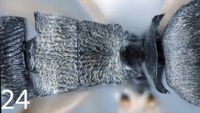Polyrhachis planata
| Polyrhachis planata | |
|---|---|

| |
| Scientific classification | |
| Kingdom: | Animalia |
| Phylum: | Arthropoda |
| Class: | Insecta |
| Order: | Hymenoptera |
| Family: | Formicidae |
| Subfamily: | Formicinae |
| Tribe: | Camponotini |
| Genus: | Polyrhachis |
| Subgenus: | Aulacomyrma |
| Species: | P. planata |
| Binomial name | |
| Polyrhachis planata Kohout, 2007 | |
Known only from the holotype.
Identification
Kohout (2007) - In general appearance and color, P. planata is similar to Polyrhachis pallipes. However, it differs from that and other Aulacomyrma species by its virtually flat pronotal dorsum and distinctly transverse petiolar node with its lateral spines strongly bent backwards.
Keys including this Species
Distribution
Distribution based on Regional Taxon Lists
Indo-Australian Region: New Guinea (type locality).
Distribution based on AntMaps
Distribution based on AntWeb specimens
Check data from AntWeb
Countries Occupied
| Number of countries occupied by this species based on AntWiki Regional Taxon Lists. In general, fewer countries occupied indicates a narrower range, while more countries indicates a more widespread species. |

|
Estimated Abundance
| Relative abundance based on number of AntMaps records per species (this species within the purple bar). Fewer records (to the left) indicates a less abundant/encountered species while more records (to the right) indicates more abundant/encountered species. |

|
Biology
|
Castes
Known only from the worker caste.
Nomenclature
The following information is derived from Barry Bolton's Online Catalogue of the Ants of the World.
- planata. Polyrhachis (Aulacomyrma) planata Kohout, 2007a: 205, figs. 21, 24, 27 (w.) NEW GUINEA.
Unless otherwise noted the text for the remainder of this section is reported from the publication that includes the original description.
Description
Worker
Holotype: TL c. 4.59; HL 1.25; HW 1.08; CI 86; SL 1.31; SI 121; PW 1.00; MTL 1.18.
Clypeus with anterior margin arcuate, entire. Sides of head weakly convex and gently converging in front of eyes towards bases of mandibles. Eyes convex, clearly breaking cephalic outline in full face view. Mesosomal dorsum distinctly marginate along entire length, pronotal and mesonotal margins converging posteriorly. Pronotal dorsum rather flat; humeri armed with broad-based, blunt teeth. Propodeal margins divergent, terminating posteriorly in blunt processes, that appear as minute teeth in profile and form short, transverse, medially unconnected ridges, so that propodeal dorsum descends into concave declivity in medially uninterrupted curve. Petiole strongly transverse, dorsal margin entire; lateral spines very distinct, strongly curved backwards and upwards. Anterior face of first gastral segment concave medially; anterodorsal border of concavity sharply margined, but not distinctly raised above dorsal surface of segment.
Mandibles very finely longitudinally striate. Head and dorsum of mesosoma more-or-less regularly striate; striae mostly longitudinal on head and dorsum of mesosoma, anteriorly converging on clypeus and oblique on sides of mesosoma. First gastral segment shagreened dorsally, longitudinally striate laterally, striae much finer than those on rest of body.
Relatively short, mostly erect, off-white or yellowish hairs, scattered over all dorsal body surfaces; hairs longer on apical segments and venter of gaster, some almost as long as greatest diameter of eye. Rather sparse, appressed, silvery pubescence scattered over dorsum of head and mesosoma dense on pronotal humeri, propodeal dorsum, along lateral and posterior borders of gastral segments and especially on metapleuron and propodeal declivity; midline of declivity glabrous.
Black. Mandibular masticatory border widely, inner mandibular border narrowly, light yellowish brown. Antennal scapes dark reddish brown; funiculi brown, segments becoming progressively lighter towards apex, apical segments yellowish brown. Legs very light, yellowish white (unique holotype may not be fully pigmented individual), only basal portion of trochanters, distal ends of femora, proximal ends of tibiae and basal tarsal segments dark, reddish-brown. Sexuals and immature stages unknown.
Type Material
HOLOTYPE: PAPUA NEW GUINEA, East Sepik Prov., 8km SSW of Dagua, 03º29’S, 143º16’E, 800m, lowland rf., 12-14.vii.1980, P.S. Ward #4747-10 (worker). Type distribution: unique holotype in Australian National Insect Collection.
Etymology
Name derived from the Latin word planus, meaning flat, alluding to its virtually flat pronotal dorsum.
References
References based on Global Ant Biodiversity Informatics
- Janda M., G. D. Alpert, M. L. Borowiec, E. P. Economo, P. Klimes, E. Sarnat, and S. O. Shattuck. 2011. Cheklist of ants described and recorded from New Guinea and associated islands. Available on http://www.newguineants.org/. Accessed on 24th Feb. 2011.
- Kohout R.J. 2007. Revision of the subgenus Aulacomyrma Emery of the genus Polyrhachis F. Smith, with descriptions of new species (pp. 186-253). In Snelling, R.R., Fisher, B.L. & Ward, P.S. (eds). Advances in ant systematics: homage to E.O. Wilson 50 years of contributions. Memoirs of the American Entomological Institute 80: 690 pp.

